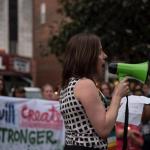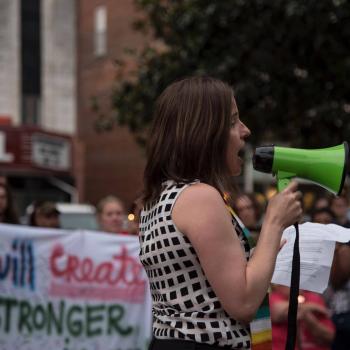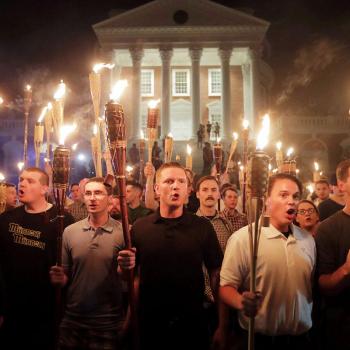Guest post: by Shawn McGuffey
When I was in elementary school I loved the Dukes of Hazzard. The funny shenanigans of Sheriff Roscoe P. Coltrane kept me laughing, while the co-stars Bo and Luke Duke’s “forget the rules” attitude appealed to my mildly rebellious spirit. And the show’s elaborate car chasing sequences kept my young heart racing. I was in awe over Uncle Jesse’s truck, Daisy’s jeep, and Boss Hogg’s impressive white, convertible Cadillac Coupe de Ville. Bo and Luke’s Dodge Charger, however, was the sitcom’s automotive centerpiece. The car was orange with welded doors, which required Bo and Luke to jump – and sometimes seemingly fly – into the vehicle. And the top of the car was adorned with white stars emblazoned on a large, blue “X”. The car was called the General Lee. I didn’t know what it meant at the time but it looked and sounded cool. And I wanted it.
I remember talking to my mom about the General Lee as a kid and I could tell that she seemed uneasy. We ended up opening several volumes of our Funk & Wagnall encyclopedia collection and some Black history texts, all of which my mother still keeps on our family bookshelf to this day. Although I knew the basics of slavery I did not know about General Robert E. Lee or this thing called the Confederacy. As I read I realized that the ‘cool’ symbol atop of my favorite car named General Lee was the Confederate Flag – a flag flown by traitorous men and women who fought to maintain ‘the right’ to enslave and kill my ancestors.
Suddenly the General Lee was not so cool. And although I did not stop watching Dukes of Hazzard cold turkey, it became less and less appealing until it was no longer a part of my must-see-TV.
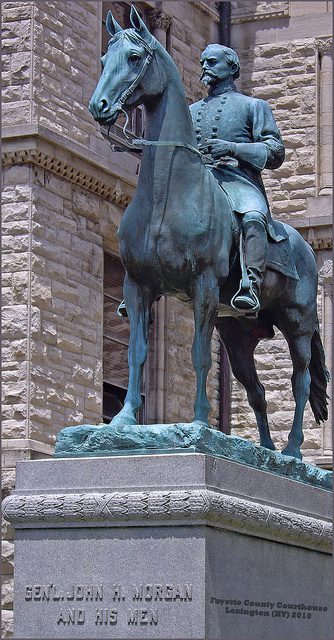
It wasn’t too long after this experience that our family was walking in our hometown of Lexington, Kentucky and we came across a statue of a man on horseback. I had seen this statue before but I had never paid much attention to the accompanying plaque. I loved animals and, honestly, I was much more fascinated with the horse than the man and I ran up to the plaque to find out about this magnificent stallion. The plaque did not contain any information about the horse. But I discovered that this man was named John Hunt Morgan – a Confederate general. I had never heard of John Hunt Morgan, but by this time I knew what ‘Confederate’ meant. It meant that the man on this granite pedestal fought to keep my family enchained.
I really don’t think I can articulate how that made me feel as a little Black boy. But I can tell you it wasn’t good.
It was only a matter of time until that I realized that flags, memorials and buildings dedicated to those who fought to keep my ancestors in chains were all over the beautiful city and state that I still lovingly call home– conspicuously displayed on courthouse lawns and university campuses.
Despite this early education on race relations, and the fact that I was well aware of the Corbin, Kentucky race riot and prominent Kentucky Klan activity, I never feared that I would be killed by White Supremacist violence. Perhaps it was because I lived in “the city” and primarily traveled between the cosmopolitan meccas of Lexington and Louisville. Besides, Klan members were most often portrayed as old, uneducated White men living in eastern and western Kentucky, places we seldom traveled. Or perhaps it was due to adolescent naivety or toxic ideas of masculine invincibility. Most likely it was a combination of all these factors. Still, the idea of being killed due to my race seemed far-fetched. Until it didn’t.
I was walking home from Jacobson Park, which, at the time, many might have considered the outskirts of the city. I could have gotten a ride from friends that were also at the park but I didn’t. It was a beautiful day and I wanted to walk, no matter how far. Along the way a flatbed truck sped by and some young, White males yelled something out of the vehicle. I could not decipher what they yelled but I assumed it was pleasant. I even waved at them, as if they were merely saying hello. A minute later, though, I noticed the truck circling back towards me.
This time their shouts did not need decoding: “Nigger!”
I was shocked into momentary immobilization. This was not the first time I had been called a nigger. Not by a long shot. But this was the first time that I had heard the racial epithet annunciated in such a way that I thought it would be the last word I would hear before I died.
The truck turned back around and I was still stunned. “Is this really happening?” The first rock barely missed my face. “Yes, this is happening.” I ran. And I found a place to hide in some bushes off the side of the road. As I hid in those bushes listening to them taunt me and detailing how they planned to kill “that nigger” I began to prepare for the worse. “If I’m going die,” I said to myself, “I’m going to die fighting.” I picked up a stick and a rock of my own and I waited to be discovered.
Luckily, I wasn’t.
Understandably my parents were distraught when I finally made it home. My mother prayed. My father made me get in the car and we went searching for that truck. We never found it. I’m not sure what would have happened if we had, but I do know that I had never seen such fire in my Dad’s eyes.
Still, what was most unsettling was having to describe the perpetrators. They were so incredibly…normal. They were not dressed in white hoods. They were not old. They were young, white males not much older than myself dressed in everyday clothes. They seemed no different than the many young, White males I had encountered in my life.
They looked like several of the young, White Supremacist in the Charlottesville rally this past weekend; the same rally where Heather Heyer, a brave woman who stood up to homegrown terrorists, was killed and another 19 hospitalized.
Strangely, the terror I felt that day in the bushes–as I listened to those men argue over who would noose me first–is not what keeps me up at night. Nor is it the horrid sight of all those White men and women in Charlottesville with torches, shouting Nazi slogans and homophobic slurs as they protected the monument of a U.S. traitor who fought to keep Black people as chattel. Condemning these acts of White rage is easy. Any decent human being can – and should – do so.
It’s the other routine, everyday practices of White Supremacy that truly worry me. Because those are the things that take more work to call out. It requires us all–you/me/we– to assess how we perpetuate systems of oppression. Identifying Nazis, fascists, and Klan members is easy when they show up en mass with torches.
The real American horror story is that these White Supremacists will go back to their normal, routine jobs – deciding who gets hired and fired, who goes to jail, who gets promoted or held back in school, who deserves a home loan and who does not, and who merits a warning versus a bullet during a routine traffic stop.
But they are not the only ones going home and blending into society; so are you/ me/us. And you/me/we will fail to recognize all the ways in which we benefit from White Supremacy and all our various unearned privileges, yet continue to perpetuate and justify the oppression of others. That’s the real nightmare.
Still, we should not minimize this recent gathering of White Supremacists, which the Southern Poverty Law Center estimated as the largest assembly of hate groups in decades. White nationalists are plainly staking a claim that they plan to take back ‘their’ country or, to put it in more popular political parlance, “To Make America Great Again.” As Trump continues to blame “many sides” for the violence and to commiserate with the “very fine people” in the White Supremacist mix, lets also be clear that he is not only sympathizing with Nazis; he is plainly justifying their terror and sanctioning White Supremacy. White Supremacists are literally tweeting thank you notes to him for the entire world to see. They see him as one of them. And he is.
Trump’s response to this White rage is certainly deplorable, though not surprising. While Trump did not create modern day racists, he certainly curated racism and xenophobia as a means to his political ends. It’s those claiming to be shocked by Trump’s abysmal conduct who really leave me confused though – as if they have been blindfolded, spun around in a circle, and their worldviews left shaken and disoriented as they attempt to navigate this place that looks like their home, this supposed meritocracy, but feels utterly warped.
Those of us in the crosshairs of Trump’s vile rhetoric and potentially devastating social policy initiatives have always recognized that the house is crooked.
We all knew what his campaign slogan meant when he repeatedly howled “Make America Great Again.” From racist diatribes about Mexican immigrants and Mexican-American lawyers, to self-proclaimed Muslim bans, to choosing one of the most homophobic politicians as his running mate, and appointing known White Supremacist to his cabinet and to the U.S. Attorney General’s office, we all knew where we were headed: to a resurgent and emboldened anti-Black, anti-semitic, misogynistic, and xenophobic covenant with the underbelly of White nationalism. Much like the era that those men who are memorialized as Confederate heroes sought to preserve.
What do we do with this groundswell of White Supremacy? I do not pretend to have any definitive answers but I do have some suggestions. And if you ever contemplated what you would do if you lived in times of extreme injustice – such as Indigenous genocide, slavery, the Holocaust, Japanese Interment camps, the Civil Rights Movement, the continuous and disproportionate killing of unarmed Black men and women by state sanctioned authorities – you no longer need to wonder because we are nearing the precipice of such a time. What are you willing to commit? What are you willing to sacrifice? What can you do?
1) Do not go back to life as usual. Life as usual is what has gotten us here in the first place. If, after Charlottesville you are still working the same, parenting the same, ministering the same, teaching the same, and/or talking to your friends and loved ones the same, then you are part of the problem. If you remain neutral, the White Supremacists win.
2) Stop saying/posting/tweeting #ThisIsNotUs. Yes, it is. It really, really is. We need to acknowledge and take stock and ownership of the ways in which we perpetuate the societal structures and cultural norms that produce the conditions that allow White Supremacy, sexism, homophobia, and classism to flourish.
3) Have difficult conversations. This is easier said than done but it is important that you/me/we keep challenging ourselves. Talk with people that have been doing the work for a good long time. They likely have knowledge and experience that can help you see the world in a more inclusive way.
4) Be prepared to get your feelings hurt. And when you do, commit yourself to keep coming back to the table. I speak from experience. I’ve spent the majority of my professional life working to understand and end violence against women in the US and abroad. I’m often the only man in these spaces. I’ve been embarrassed and yelled at on several occasions because I asked foolish questions. I certainly got my feelings hurt. But I did not run away. I stayed. I listened. And I thanked the women for making me a better person. We have to be willing to put ourselves out there and to make mistakes if we are truly committed to doing this work.
5) Donate your time and money to organizations that are doing the work. Do some research. Support groups where your skill set best meets the need. It’s one thing to “like” or post an article on Facebook but we need you out in those streets – and in the boardrooms, houses of worship and social justice organizations.
6) At the same time, don’t underestimate the power of social media. #BlackLivesMatter, #WomensMarch, and others have demonstrated that social media can be a formidable organizational tool. Use it wisely.
7) Get involved in the political system. I know that many are politically fatigued but it’s important that we call our local representatives, encourage others to vote and work to repeal restrictive voting laws that disproportionately and negatively impact Black and Brown communities.
8) And, for goodness sake, model the advocates in my hometown that effectively worked to relocate Confederate monuments. Historians have demonstrated that Confederate memorials were erected primarily to intimidate Black people and their allies. As a scholar, I assure you that we are not trying to rewrite or forget the past. On the contrary, we need to know our history so that we can help make sense of what is happening today. We are simply asking that turncoats and those that fought to kill, rape, and to keep people of African descent in perpetual servitude not be revered as national heroes, effectively solidifying racism in stone (and sometimes children’s toys). Between Google, museums and good old-fashioned books I assure you that the Civil War will not be forgotten.
If you’re still not there yet and you believe the mythology that the Civil War was not about slavery, I suggest that you read the declaration of causes that explained rationales for leaving the Union. In short, in the declaration of causes you will find: a) an unambiguous defense of slavery; b) some seceding states making the case that slavery should be expanded; c) an admonishment of abolitionism because the possibility of freedom encouraged slave revolts; d) Georgia and Mississippi both suggesting that slavery was essential to the Southern economy; and e) the Confederacy suggesting that the compact between states and the federal government was null and void because Northern states often refused to enforce the Fugitive Slave Act of 1850, which required that runaway slaves be returned to the South.
If you’re still not convinced that these memorials should be relocated, then perhaps you will accept the perspective of the great-great grandchildren of Jefferson Davis, Stonewall Jackson, and Robert E. Lee, all of whom advocate for the removal and/or relocation of the memorials of their infamous relatives. Still not persuaded? How about following the lead of General Lee himself who not only opposed Confederate monuments, but also wanted to purge the Confederate Flag from public spaces after the Civil War. And if you’re still on the fence, I want you to imagine yourself as my parents: attempting to explain to their two young, Black sons why an army of pro-slavery, treasonous men and women fighting against racial progress should be glorified, put on a literal pedestal and outstandingly displayed in public places.
And if you’re still not convinced? Then shame on you.
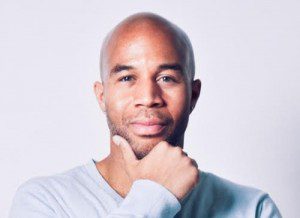 C. Shawn McGuffey, Ph.D., is an Associate Professor of Sociology and African & African Diaspora Studies at Boston College. A native of Lexington, Kentucky, his scholarly work primarily highlights how race, gender, sexuality and social class both constrain and create the choices survivors pursue in the aftermath of trauma. Two of his current projects focus on sexual trauma. One examines how gender, sexuality, and race shape parental responses to child sexual abuse; and the other investigates the social psychology of Black rape survivors in the U.S., Ghana and South Africa. A third project investigates the ways in which Darfurian genocide survivors navigate the International Criminal Court; and a fourth examines Black LGBT views on same-sex marriage and civic engagement. McGuffey is the recipient of three American Sociological Association section awards: the 2006 Sally Hacker Award for research excellence, a 2009 “Best Research Article Award,” and a 2016 “Distinguished Article Award.” In 2016 he also received the Kimberlé Crenshaw Award from the Society for the Study of Social Problems. The Ford Foundation, a Research Incentive Grant, and the Institute for Liberal Arts have supported his research. He has given invited lectures at the Center for Children and Childhood Studies at Rutgers University, The Center for the Study of Violence and Prevention at the University of Colorado, Harvard University, and the University of the Western Cape in South Africa.
C. Shawn McGuffey, Ph.D., is an Associate Professor of Sociology and African & African Diaspora Studies at Boston College. A native of Lexington, Kentucky, his scholarly work primarily highlights how race, gender, sexuality and social class both constrain and create the choices survivors pursue in the aftermath of trauma. Two of his current projects focus on sexual trauma. One examines how gender, sexuality, and race shape parental responses to child sexual abuse; and the other investigates the social psychology of Black rape survivors in the U.S., Ghana and South Africa. A third project investigates the ways in which Darfurian genocide survivors navigate the International Criminal Court; and a fourth examines Black LGBT views on same-sex marriage and civic engagement. McGuffey is the recipient of three American Sociological Association section awards: the 2006 Sally Hacker Award for research excellence, a 2009 “Best Research Article Award,” and a 2016 “Distinguished Article Award.” In 2016 he also received the Kimberlé Crenshaw Award from the Society for the Study of Social Problems. The Ford Foundation, a Research Incentive Grant, and the Institute for Liberal Arts have supported his research. He has given invited lectures at the Center for Children and Childhood Studies at Rutgers University, The Center for the Study of Violence and Prevention at the University of Colorado, Harvard University, and the University of the Western Cape in South Africa.
He has also written op-ed and guest blog essays on the George Zimmerman verdict, Bashir and the International Criminal Court, and the Orlando Massacre among others.
In his free time Shawn enjoys volunteering with his therapy dog, practicing the art of Brazilian Jiu Jitsu, and competitive eating competitions. Pies and cupcakes are his gastronomic specialties.

